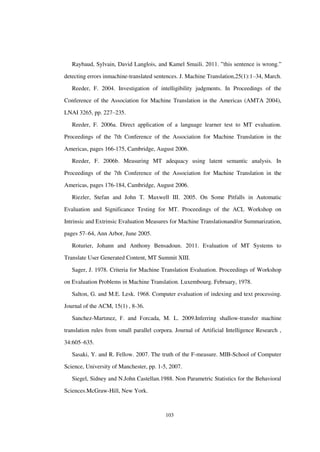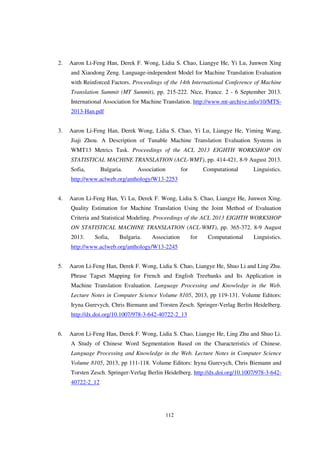This thesis proposes new machine translation evaluation metrics called LEPOR that aim to address issues with existing methods. LEPOR incorporates additional evaluation factors like length penalty and n-gram position difference penalty to provide more accurate assessments. It also explores using part-of-speech tags as linguistic features. Experimental results on multiple language pairs show LEPOR achieves strong performance, correlating highly with human judgments of translation quality. The metrics were also submitted to the ACL-WMT shared translation evaluation task where they proved robust across different languages.
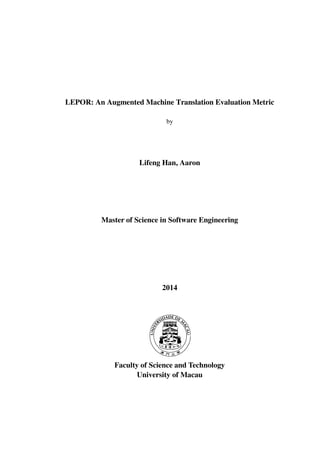




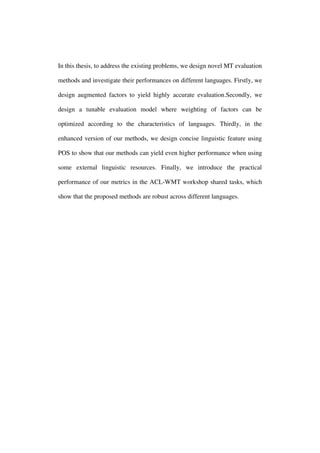



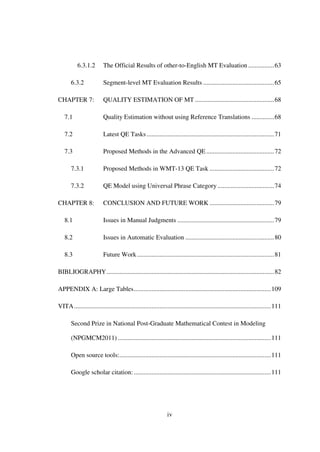














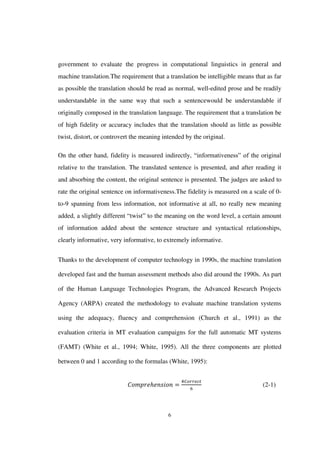





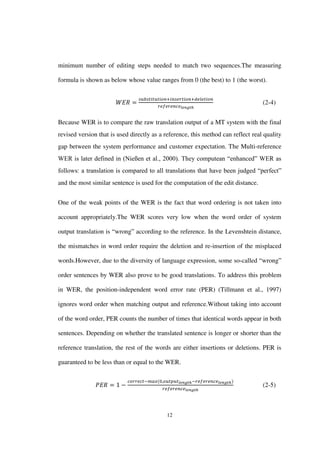

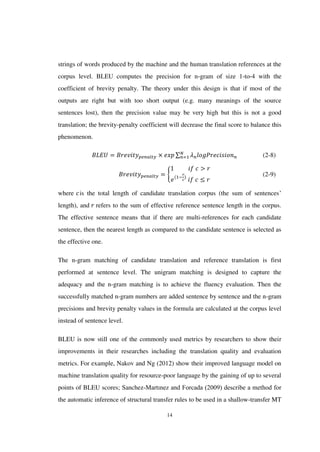
![15
system from small parallel corpora with the verifying metrics TER and BLEU; Li et al.
(2011) propose a feedback selecting algorithm for manually acquired rules employed
in a Chinese to English MT system stating the improvement of SMT quality by 17.12%
and by 5.23 in terms ofcase-insensitive BLEU-4 score over baseline. Actually, BLEU
has a wider applicability than just MT. Alqudsi et al. (2012) extend its use to evaluate
the generation of natural language and the summarization of systems.
In the BLEU metric, the n-gram precision weight is usually selected as uniform
weight . However, the 4-gram precision value is usually very low or even zero
when the test corpus is small. Furthermore, the geometric average results in 0 score
whenever one of the component n-grams scores is 0. To weight more heavily those n-
grams that are more informative, Doddington (2002) proposes the NIST metric with
the information weight added.
(2-10)
Furthermore, he replace the geometric mean of co-occurrences with the arithmetic
average of n-gram counts, extend the n-gram into 5-gram (N=5), and select the
average length of reference translations instead of the nearest length. The arithmetic
mean ensures that the co-occurrence for different n-gram can be weighted.
∑ {
∑
∑
} { [ (̅̅̅̅̅̅
)]} (2-11)
where means the words sequence, ̅̅̅̅̅̅ is the average number of words in a
reference translation, averaged over all reference translations. The experiments show
that NIST provides improvement in score stability and reliability, and higher
correlation with human adequacy judgments than BLEU on four languages, Chinese,
French, Japanese and Spanish. However, NIST correlates lower with the human
Fluency judgments than BLEU on the other three corpora except for Chinese.](https://image.slidesharecdn.com/32f8b9ff-c5ed-438a-8775-6a71be4ca794-160714101615/85/Thesis-Master-MTE-Aaron-34-320.jpg)







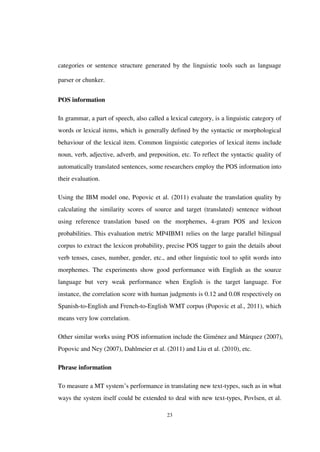











![35
Pearson's correlation coefficient when applied to a population is commonly
represented by the Greek letter (rho). The correlation between random variables X
and Y denoted as is measured as follow (Montgomery and Runger,1994;
Montgomery and Runger, 2003).
√
(2-24)
Because the standard deviations of variable X and Y are higher than 0( and
), if the covariance between X and Y is positive, negative or zero, the
correlation score between X and Y will correspondingly result in positive,
negative or zero, respectively. Forany two random variables, the correlation score of
them varies in the following interval:
(2-25)
The correlation just scales the covariance by the standard deviation of each variable.
Consequently the correlation is a dimensionless quantity that can be used to compare
the linear relationships between pairs of variables in different units.In the above
formula, the covariance between the random variables X and Y, denoted as cov(X, Y)
or , is defined as:
[ ] (2-26)
To learn the above formula, let’s first see a definition: a discrete random variable is a
random variable with a finite (or countably infinite) range; a continuous random
variable is a random variable with an interval (either finite or infinite) of real numbers
for its range. The mean or expected value of the discrete random variable X, denoted
as or E(X), is
∑ (2-27)
A random variable X has a discrete uniform distribution if each of the n values in its
range, say , has equal probability. Then,](https://image.slidesharecdn.com/32f8b9ff-c5ed-438a-8775-6a71be4ca794-160714101615/85/Thesis-Master-MTE-Aaron-54-320.jpg)

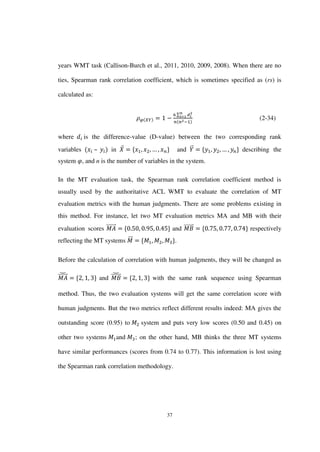











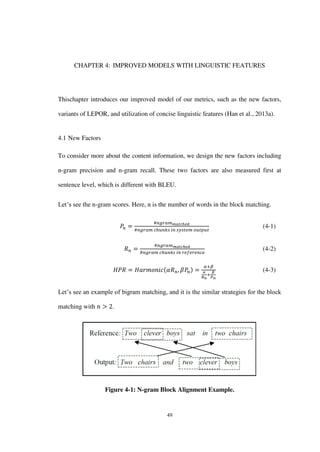

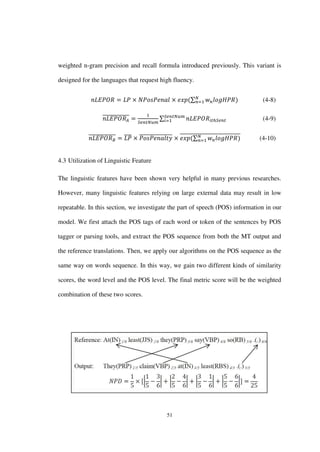

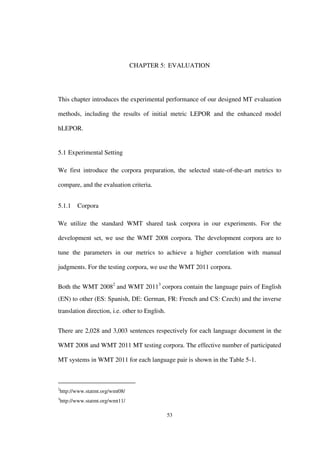





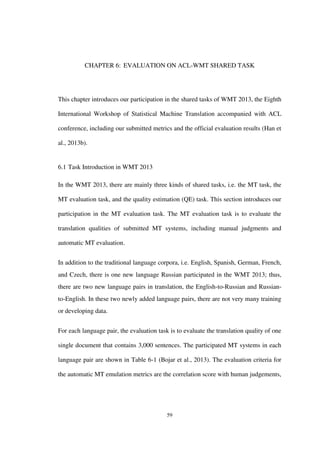











![71
7.2 Latest QE Tasks
The latest quality estimation tasksof MT can be found in WMT12 (Callison-Burch et
al., 2012) and WMT134
. For the ranking task, they defined a novel task evaluation
metric that provides some advantages over the traditional ranking metrics. The
designed criterion DeltaAvg assumes that the reference test set has a number
associated with each entry that represents its extrinsic value. For instance, using the
effort scale, they associatea value between 1 and 5 with each sentence, representing
the quality of that sentence. Given these values, their metric does not need an explicit
reference ranking, the way the Spearman ranking correlation does. The goal of the
DeltaAvg metric is to measure how valuable a proposed ranking (hypothesis ranking)
is according to the extrinsic values associated with the test entries.
[ ]
∑
(7-1)
For the scoring task, they usetwo task evaluation metrics that have been traditionally
used for measuring performance for regression tasks: Mean Absolute Error (MAE) as
a primary metric, and Root of Mean Squared Error (RMSE) as a secondary metric.
For a given test set S with entries , , they denoteby the proposed
score for entry (hypothesis), and by the reference value for entry (gold-
standard value). They formally define the metrics as follows.
∑
(7-2)
√∑ ( )
(7-3)
4
http://www.statmt.org/wmt13/quality-estimation-task.html](https://image.slidesharecdn.com/32f8b9ff-c5ed-438a-8775-6a71be4ca794-160714101615/85/Thesis-Master-MTE-Aaron-90-320.jpg)











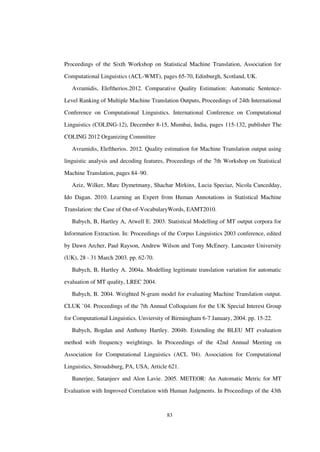

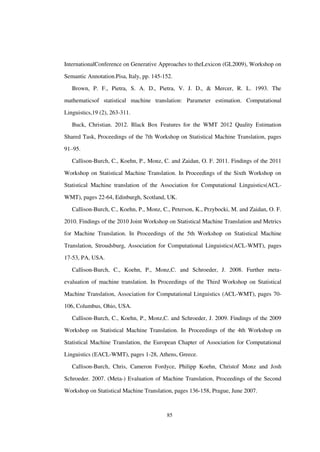



![89
EAGLES. 1996. EAGLES Evaluation of Natural Language Processing Systems. Final
Report. EAGLES Document EAG-EWG-PR.2, Center for Sprogteknologi, Copenhagen.
Echizen-ya, H. and Araki, K. 2010. Automatic evaluation method for machine
translation using noun-phrase chunking. In Proceedings of ACL 2010, pages 108–117.
Association for Computational Linguistics.
Eck, Matthias and Chiori Hori. 2005. Overview of the IWSLT 2005 Evaluation
Campaign, IWSLT 2005.
Federico, Marcello, Luisa Bentivogli, Michael Paul, and Sebastian Stiiker. 2011.
Overview of the IWSLT 2011 Evaluation Campaign, 11-27.
Federmann, Christian. 2011. How can we measure machine translation quality?,
Tralogy [En ligne], Session 5 - Quality in Translation / La qualité en traduction, mis à jour
le : 18/11/2011,URL : http://lodel.irevues.inist.fr/tralogy/index.php?id=76.
Federmann, Christian. 2012. Appraise: an Open-Source Toolkit for Manual Evaluation
of MT Output. The Prague Bulletin of Mathematical Linguistics No. 98, 2012, pp. 25–35.
doi: 10.2478/v10108-012-0006-9.
Felice, Mariano and Lucia Specia. 2012. Linguistic Features for Quality Estimation.
Proceedings of the 7th Workshop on Statistical Machine Translation, pages 96–103.
Fellbaum, C. 1998. WordNet: An Electronic Lexical Database. MIT Press.
http://www.cogsci.princeton.edu/˜wn [2000, September 7].
Finkel, Jenny R. and Christopher D. Manning. 2010. Hierarchicaljoint learning:
improving joint parsing andnamed entity recognition with non-jointly labeled data.In 48th
Annual Meeting of the Association for ComputationalLinguistics, pages 720–728, Uppsala,
Sweden.
Finkel, Jenny Rose, Trond Grenager, and Christopher Manning. 2005. Incorporating
non-local information into information extraction systems by gibbs sampling. In
Proceedings of the 43rd Annual Meeting on Association for Computational Linguistics,
ACL 2005, pages 363–370, Stroudsburg, PA, USA.](https://image.slidesharecdn.com/32f8b9ff-c5ed-438a-8775-6a71be4ca794-160714101615/85/Thesis-Master-MTE-Aaron-108-320.jpg)







![97
Liu, Ding and Daniel Gildea. 2005. Syntactic features for evaluation of machine
translation. In Proceedings of the ACL Workshop on Intrinsic and Extrinsic Evaluation
Measures for Machine Translation and/or Summarization, pages 25-32.
Liu, Ding and Daniel Gildea. 2006. Stochastic iterative alignment for machine
translation evaluation. Procedding of ACL-06. Sydney.
Liu, Ding and Daniel Gildea. 2007. Maximum Correlation Training for Machine
Translation Evaluation, 2007 NAACL.
Lo, Chi-kiu and Dekai Wu. 2011a. MEANT: An Inexpensive, High- Accuracy, Semi-
Automatic Metric for Evaluating Translation Utility based on Semantic Roles. Proceedings
of the 49th Annual Meeting of the Association for Computational Linguistics, pages 220–
229, Portland, Oregon, June 19-24.
Lo, Chi-kiu and Dekai Wu. 2011b. SMT vs. AI redux: How semantic frames evaluate
MT more accurately. In Proceedings of the 22nd International Joint Conference on
Artificial Intelligence (IJCAI-11).
Lo, Chi-kiu and Dekai Wu. 2011c. Structured vs. Flat Semantic Role Representations
for Machine Translation Evaluation. In Proceedings of the 5th Workshop on Syntax and
Structure in Statistical Translation (SSST-5).
Lo, Chi-kiu, Anand Karthik Tumuluru and Dekai Wu. 2012. Fully Automatic Semantic
MT Evaluation. Proceedings of the 7th Workshop on Statistical Machine Translation,
pages 243–252, Montreal, Canada, June 7-8. Association for Computational Linguistics.
Ma, Xiaoyi. 2006. Multiple-Translation Chinese (MTC)part 4. Linguistic Data
Consortium.
Mariani, Joseph. 2011. Report of the Session 5 of Tralogy: Quality in Translation,
Tralogy [En ligne], Session 5 - Quality in Translation / La qualité en traduction, mis à jour
le : 17/10/2011,URL: http://lodel.irevues.inist.fr/tralogy/index.php?id=160&format=print.
Mariño,José B., Rafael E. Banchs, Josep M. Crego, Adrià de Gispert, Patrik Lambert,
José A. Fonollosa, Marta R. Costa-jussà. 2006. N-gram based machine translation.
Computational Linguistics, Vol. 32, No. 4. pp. 527-549, MIT Press.](https://image.slidesharecdn.com/32f8b9ff-c5ed-438a-8775-6a71be4ca794-160714101615/85/Thesis-Master-MTE-Aaron-116-320.jpg)
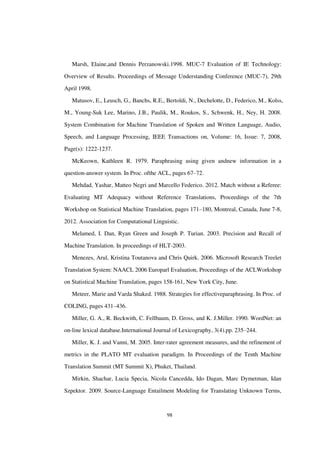
![99
Proceedings of the Joint Conference of the 47th Annual Meeting of the ACL and the 4th
International Joint Conference on Natural Language Processing of the AFNLP, pages 791–
799, Suntec, Singapore, 2-7 August 2009. ACL and AFNLP.
Mladenić, Dunja and Marko Grobelnik. 1998. Featureselection for classification based
on text hierarchy. InConference on Automated Learning and Discovery(CONALD-98).
Montgomery, D.C. and Runger, G.C. 1994. Applied statistics and probability for
engineers, page. John Wiley & Sons New York.
Montgomery, D.C. and Runger, G.C. 2003. Applied statistics and probability for
engineers(third edition), page. John Wiley & Sons New York.
Moran,John and David Lewis. 2012. Unobtrusive methods for low-cost manual
assessment of machine translation. Tralogy [Online], Session 5 - Quality in Translation /
quality in translation, updated on: 16/07/2012, URL:
http://lodel.irevues.inist.fr/tralogy/index.php?id=141
Munkres, J. 1957. Algorithms for the Assignment and Transportation Problems. Journal
of the Society for Industrial and Applied Mathematics, 5:32–38.
Mutton, Andrew, Mark Dras, Stephen Wan and Robert Dale. 2007. GLEU: Automatic
Evaluation of Sentence-Level Fluency, Proceedings of the 45th Annual Meeting of the
Association of Computational Linguistics, pages 344–351, Prague, Czech Republic, June
2007. 2007 Association for Computational Linguistics.
Nagao, M. 1984. A framework of a mechanical translation between English and
Japaneseby analogy principle. In Elithorn, A., & Banerji, R. (Eds.), Artificialand
HumanIntelligence, pp. 173-180. North-Holland.
Nakov, P. and H. T. Ng. 2012. Improving Statistical Machine Translation for a
Resource-Poor Language Using Related Resource-Rich Languages, Journal of Artificial
Intelligence Research Vol.44 (2012) 179-222.
Naskar, Sudip Kumar, Antonio Toral, Federico Gaspari and Andy Way. 2011.
Framework for Diagnostic Evaluation of MT Based on Linguistic Checkpoints, in MT
Summit 2011.](https://image.slidesharecdn.com/32f8b9ff-c5ed-438a-8775-6a71be4ca794-160714101615/85/Thesis-Master-MTE-Aaron-118-320.jpg)



